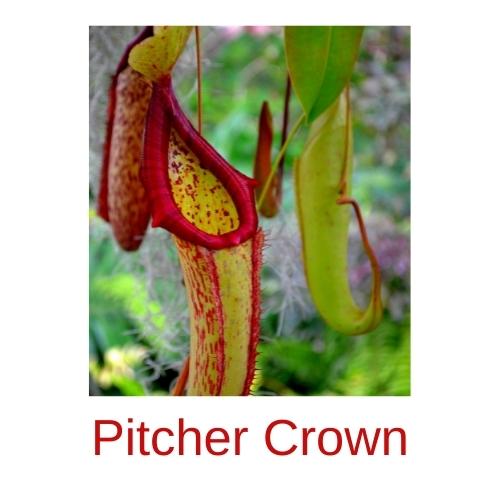
Introduction to Asian Pitcher Plant
Welcome to the fascinating world of Asian Pitcher Plants! These unique plants are a marvel of nature and a testament to the incredible diversity of Asian flora. In this post, we will explore the definition, unique characteristics, and types of Asian Pitcher Plants.
- Definition of Asian Pitcher Plant
- Unique Characteristics of Asian Pitcher Plant
- Types of Asian Pitcher Plants
- Nepenthes rajah: Known for its giant size, it can hold up to 2.5 liters of water in its pitcher.
- Nepenthes alata: Recognized by its slender, elongated pitchers and widespread distribution.
- Nepenthes bicalcarata: Notable for its two long, fang-like protrusions from the lid of the pitcher.
The Asian Pitcher Plant, scientifically known as Nepenthes, is a genus of carnivorous plants that are native to the tropical regions of Asia. These plants are known for their unique pitcher-shaped leaves, which they use to trap and digest insects. The name ‘Nepenthes’ comes from Greek mythology, where it was a magical potion that could eliminate sorrow and suffering.
Asian Pitcher Plants are unique in several ways. Firstly, they are one of the few plants in the world that are carnivorous, meaning they eat meat. They achieve this through their specialized pitcher-shaped leaves, which contain a pool of digestive enzymes. Insects, lured by the plant’s sweet nectar, fall into the pitcher and are digested by these enzymes. Secondly, these plants are adapted to grow in nutrient-poor soil, and they supplement their nutrient intake by digesting insects. Lastly, the size, shape, and color of the pitcher vary greatly among different species, making each type of Asian Pitcher Plant unique.
There are over 150 known species of Asian Pitcher Plants, each with its unique characteristics. Some of the most notable ones include:
In conclusion, Asian Pitcher Plants are a fascinating group of plants that showcase the incredible biodiversity of the Asian region. Their unique adaptations and wide variety of species make them a captivating subject of study for botanists and nature enthusiasts alike.
Discovering Asian Flora
Asia, a continent known for its diverse culture, is also home to a vast array of unique plant life. This section will take you on a journey to explore the wild landscapes of Asia and the role of one particular plant, the Asian Pitcher Plant, in the ecosystem.
Wild Asian Landscapes
Asia’s landscapes are as diverse as its flora. From the lush rainforests of Southeast Asia to the arid deserts of Central Asia, each region has its unique vegetation and wildlife.
- Overview of Asian Landscapes
- Role of Asian Pitcher Plant in the Ecosystem
Asia’s landscapes can be broadly divided into five types: tropical rainforests, temperate forests, grasslands, deserts, and tundra. Each of these landscapes supports a unique set of plant and animal life. For instance, the tropical rainforests of Southeast Asia are known for their high biodiversity, including a wide variety of orchids and ferns.
| Landscapes | Examples of Flora |
|---|---|
| Tropical Rainforests | Orchids, Ferns, Asian Pitcher Plant |
| Temperate Forests | Oaks, Maples, Rhododendrons |
| Grasslands | Grasses, Wildflowers |
| Deserts | Cacti, Succulents |
| Tundra | Mosses, Lichens |
The Asian Pitcher Plant, also known as Nepenthes, plays a crucial role in the ecosystem. This carnivorous plant helps control insect populations, thus maintaining a balance in the ecosystem. Its unique pitcher-shaped leaves, filled with a liquid that attracts and drowns insects, are a marvel of nature’s design.
Moreover, the Asian Pitcher Plant is a source of nutrients for many small animals. Some species of ants, for instance, have evolved to live in these plants and feed on the drowned insects. Thus, the Asian Pitcher Plant not only contributes to the ecosystem’s health but also supports a mini-ecosystem within its pitchers.
Exploring Asian Nature: Asian Pitcher Plant Habitats
The Asian Pitcher Plant, also known as Nepenthes, is a fascinating species of carnivorous plant native to the diverse landscapes of Asia. This plant is known for its unique pitcher-shaped leaves that trap insects and small animals. Today, we will explore the geographical locations and climate conditions of the Asian Pitcher Plant habitats.
-
Geographical Locations of Asian Pitcher Plant Habitats
The Asian Pitcher Plant is found in a wide range of geographical locations across Asia. These include the rainforests of Borneo, Sumatra, and the Philippines, the highlands of Malaysia and Indonesia, and even the mountainous regions of China and India.
Each of these locations offers unique conditions that the Asian Pitcher Plant has adapted to. For instance, in the rainforests, these plants often grow as climbers, using their tendrils to latch onto trees and reach for sunlight. In the highlands, they are more likely to be found growing on the ground, taking advantage of the cool, moist conditions.
It’s fascinating to note that the Asian Pitcher Plant’s geographical spread is a testament to its adaptability and resilience. Despite the varied environments, this plant has found ways to thrive and survive.
-
Climate Conditions of Asian Pitcher Plant Habitats
The climate conditions of the Asian Pitcher Plant habitats are as diverse as their geographical locations. These plants are found in both tropical and subtropical climates, with temperatures ranging from 20°C to 30°C. They prefer high humidity levels, often above 60%, and require ample rainfall throughout the year.
In the highlands, where temperatures can drop to 10°C, the Asian Pitcher Plant has adapted to survive the cold by developing a thick, waxy cuticle on its leaves. This helps to prevent water loss and protect the plant from frost damage.
Despite these harsh conditions, the Asian Pitcher Plant continues to flourish, demonstrating its remarkable adaptability and resilience. It’s a testament to the plant’s ability to evolve and adapt to its environment.
In conclusion, the Asian Pitcher Plant is a fascinating example of nature’s adaptability. Whether in the rainforests of Borneo or the highlands of Malaysia, this plant has found a way to thrive in diverse climates and geographical locations. It’s a testament to the wonders of Asian nature and the resilience of life on our planet.
Asian Pitcher Plant Ecosystem
The Asian Pitcher Plant, also known as Nepenthes, is a fascinating species that plays a vital role in its ecosystem. This unique plant has developed an extraordinary survival strategy, which allows it to thrive in nutrient-poor soils. Let’s delve deeper into the interactions of the Asian Pitcher Plant with other species in its ecosystem.
Interactions with Other Species
Interactions between different species are crucial for the balance of an ecosystem. The Asian Pitcher Plant is no exception. It has two main interactions that are worth discussing: its role as a carnivorous plant and its relationship with insect species.
- Asian Pitcher Plant as a Carnivorous Plant
- Asian Pitcher Plant and Insect Species
The Asian Pitcher Plant is one of the most well-known carnivorous plants. It has evolved to trap and digest insects, which provides it with the nutrients it needs to survive in nutrient-poor environments. The plant’s pitcher-shaped leaves are filled with a sweet-smelling nectar that attracts insects. Once the insects land on the slippery rim of the pitcher, they fall into the liquid inside and are digested by the plant. This unique adaptation allows the Asian Pitcher Plant to thrive in environments where other plants struggle.
Despite being a carnivorous plant, the Asian Pitcher Plant also has a symbiotic relationship with certain insect species. Some insects, such as the Pitcher Plant Mosquito and the Pitcher Plant Fly, have evolved to live and breed in the liquid inside the plant’s pitchers without being digested. These insects help the plant by breaking down the trapped prey into more easily digestible forms. In return, the plant provides a safe habitat for the insects to live and reproduce. This is a perfect example of mutualism, where both species benefit from the relationship.
In conclusion, the Asian Pitcher Plant is a fascinating example of adaptation and survival. Its unique interactions with other species highlight the complexity and beauty of nature. By understanding these interactions, we can gain a greater appreciation for the intricate balance of our planet’s ecosystems.
Asian Pitcher Plant Locations
The Asian Pitcher Plant, a fascinating species of carnivorous flora, is found in various locations across Asia. Let’s delve into the details of where these plants are primarily located and the conservation status of their habitats.
- Mapping the Distribution of Asian Pitcher Plants
The Asian Pitcher Plant, scientifically known as Nepenthes, is predominantly found in Southeast Asia. The distribution of these plants is quite widespread, spanning over a large geographical area. They are native to countries like Indonesia, Malaysia, the Philippines, and Thailand.
These plants thrive in a variety of environments, from the tropical rainforests at sea level to the high-altitude cloud forests in the mountains. The highest concentration of Asian Pitcher Plants is found in Borneo and Sumatra, with a significant number also present in the Philippines.
Here’s a simple table to illustrate the distribution:
Country Number of Species Indonesia (Borneo and Sumatra) Approximately 80 Malaysia Approximately 50 Philippines Approximately 35 Thailand Approximately 5 - Conservation Status of Asian Pitcher Plant Habitats
Despite their wide distribution, the habitats of Asian Pitcher Plants are under threat due to human activities. Deforestation, urban development, and climate change are the major threats to these unique ecosystems.
Many species of Asian Pitcher Plants are listed as ‘Vulnerable’ or ‘Endangered’ on the IUCN Red List of Threatened Species. This is a clear indication that urgent conservation efforts are needed to protect these unique plants and their habitats.
Conservation initiatives include the establishment of protected areas, habitat restoration, and public education about the importance of these plants and their role in the ecosystem. These efforts aim to ensure the survival of Asian Pitcher Plants for future generations to study and appreciate.
Wild Plant Habitats: A Case Study on Asian Pitcher Plants
Asian Pitcher Plants are fascinating examples of the rich biodiversity found in Asia. These unique plants have adapted to thrive in challenging environments, making them a fascinating subject for study. Let’s delve into the world of these intriguing plants and their wild habitats.
Discovering Pitcher Plants in the Wild
Exploring the wild habitats of the Asian Pitcher Plants is an adventure in itself. It involves careful planning, field research, and a keen eye for detail. Let’s take a closer look at the methods used in this field research and the key findings that emerged from it.
- Field Research Methods
- Key Findings and Takeaways
Field research on Asian Pitcher Plants involves a combination of observation, data collection, and analysis. Researchers often trek through dense forests and climb steep hills to reach the habitats of these plants. They use tools like GPS for accurate location tracking, cameras for visual documentation, and notebooks for recording observations. The collected data is then analyzed to understand the plant’s growth patterns, habitat preferences, and survival strategies.
The research on Asian Pitcher Plants has led to some fascinating discoveries. For instance, these plants have a unique way of trapping insects for nutrition, using a pitcher-like structure filled with a sweet-smelling liquid. They also show a preference for humid, shaded environments. These findings have not only enriched our understanding of these plants but also highlighted the importance of preserving their natural habitats.
In conclusion, the Asian Pitcher Plants are a testament to the wonders of nature. Their unique survival strategies and adaptation to challenging habitats make them a fascinating subject for study. As we continue to explore the wild plant habitats of Asia, we hope to uncover more such wonders and deepen our understanding of the world around us.
Asian Plant Exploration: Future Prospects
As we delve deeper into the fascinating world of Asian pitcher plants, it becomes evident that our exploration is far from over. There are still many uncharted territories and undiscovered species. The future of Asian plant exploration is bright, with numerous opportunities for research and conservation efforts. Let’s take a closer look at these prospects.
- Importance of Conservation Efforts
- Future Research Directions for Asian Pitcher Plants
Conservation is a critical aspect of plant exploration. It’s not just about discovering new species; it’s also about preserving the ones we already know. Asian pitcher plants, like many other plant species, are under threat from habitat loss and climate change. Conservation efforts can help protect these unique plants and ensure their survival for future generations.
Conservation also plays a vital role in maintaining the balance of our ecosystems. Each plant species has a specific role in its ecosystem, and the loss of one can have a ripple effect on the entire system. By conserving plant species, we are also protecting the health of our planet.
Asian pitcher plants are a treasure trove of scientific knowledge waiting to be unlocked. Their unique adaptations and survival strategies make them a fascinating subject for research. Future studies could focus on understanding these adaptations better and discovering how they can be applied in other fields, such as medicine and agriculture.
Another exciting area of research is the study of pitcher plant ecosystems. These plants create their own mini-ecosystems, hosting a variety of organisms from insects to microorganisms. Studying these ecosystems could provide valuable insights into biodiversity and ecosystem dynamics.
In conclusion, the future of Asian plant exploration holds immense potential. With continued research and conservation efforts, we can uncover the secrets of these fascinating plants and ensure their survival for generations to come.








